Honor Award
Backyard Farm Service: A Business Plan for Localizing Food Production

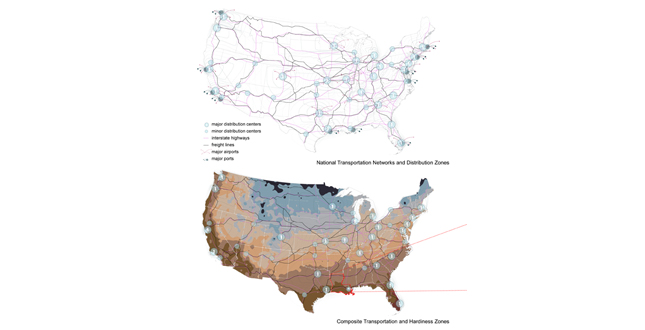
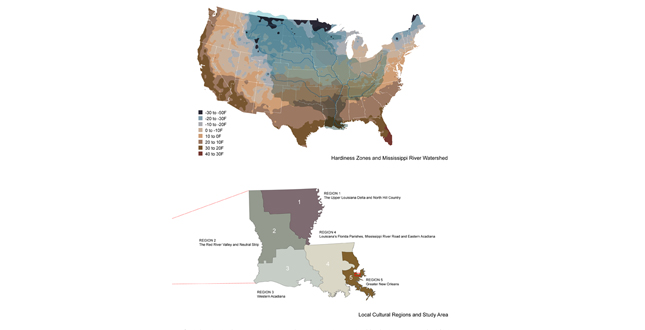 Close Me!
Close Me!Food Delivery. Overlaying plant hardiness zones and transportation networks underscores the disjunction between conventional food delivery and local conditions. We use New Orleans as the site with which to develop our research and proposal.
Download Hi-Res ImageImage: Visual Logic
Image 3 of 13
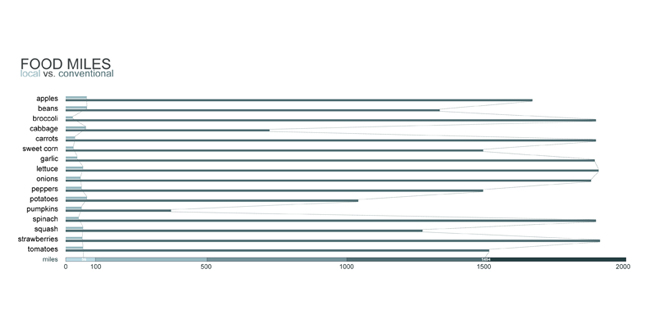 Close Me!
Close Me!Food Delivery. Conventional produce, even if grown in the United States, travels an average of 1,500 miles before it is sold. Locally-grown produce travels an average of 56 miles.
Download Hi-Res ImageImage: Visual Logic
Image 4 of 13
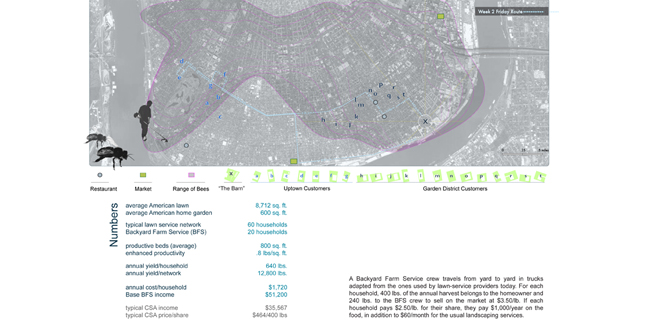 Close Me!
Close Me!Farming — Service. A Backyard Farm Service crew travels from yard to yard in trucks adapted from the ones used by lawn-service providers today. For each household, 400 lbs, of the annual harvest belongs to the homeowner and 240 lbs. to the BFS crew to sell on the market at $3.50/lb. If each household pays $2.50/lb. for their share, they pay $1,000/year on the food, in additional to $60/month for the usual landscape services.
Download Hi-Res ImageImage: Visual Logic
Image 5 of 13
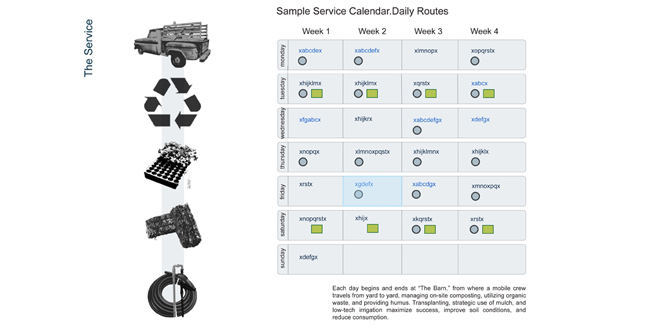 Close Me!
Close Me!Farming — Service. Each day begins and ends at "The Barn," from where a mobile crew travels from yard to yard, managing on-site composting, utilizing organic waste, and providing humus. Transplanting, strategic use of mulch, and low-tech irrigation maximize success, improve soil conditions, and reduce consumption.
Download Hi-Res ImageImage: Visual Logic
Image 6 of 13
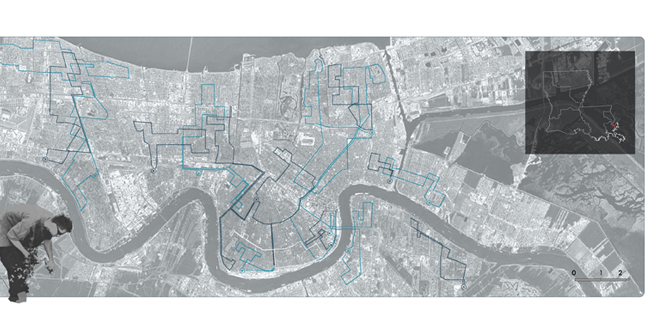 Close Me!
Close Me!Farming — Service. The proposal's urban farming crews tie into the existing system of local food production, distribution, and consumption, with each crew establish relationships with homeowners, restaurants, grocery stores, farmers markets, caterers, and schools in order to develop markets for locally-grown produce.
Download Hi-Res ImageImage: Visual Logic
Image 7 of 13
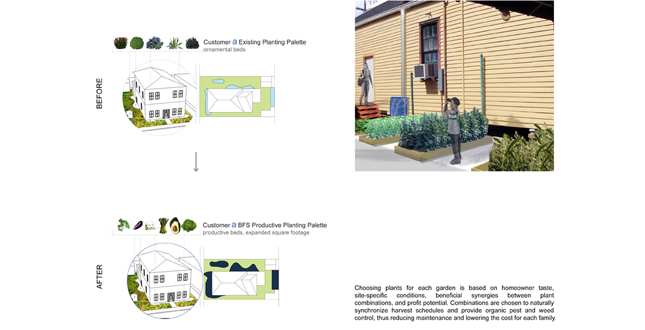 Close Me!
Close Me!Choosing plants for each garden is based on homeowner taste, site-specific conditions, beneficial synergies between plant combinations, and profit potential. Combinations are chosen to naturally synchronize harvest schedules and provide organic pest and weed control, thus reducing maintenance and lowering the cost for each family.
Download Hi-Res ImageImage: Visual Logic
Image 8 of 13
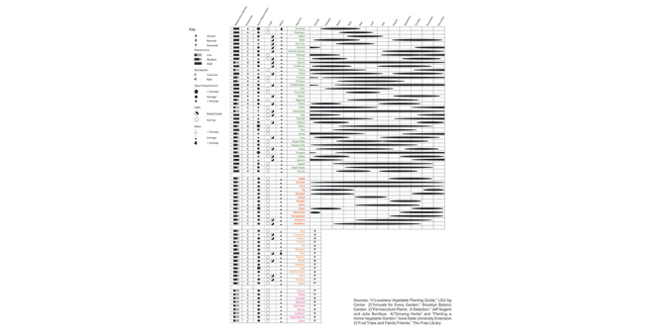 Close Me!
Close Me!Implementation. The plants in each combination work together to enhance harvest schedules and to provide organic pest and weed control, thus reducing the amount of maintenance required and lowering the cost of having a garden for each family. Since BFS farms a number of different sites, households and business will benefit from the diversity of crops that arises due to the varied planting strategies used across the entire network.
Download Hi-Res ImageImage: Visual Logic
Image 9 of 13
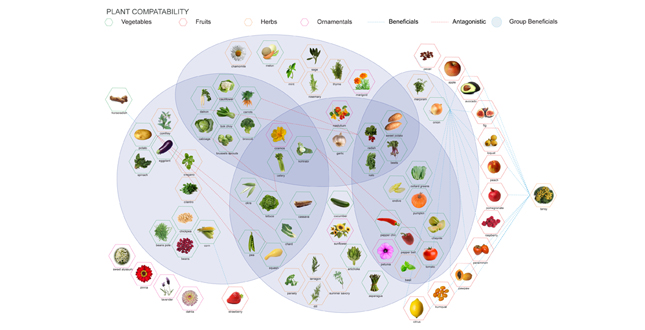 Close Me!
Close Me!Planting, Local Conditions. Plant Compatibility.
Download Hi-Res ImageImage: Visual Logic
Image 10 of 13
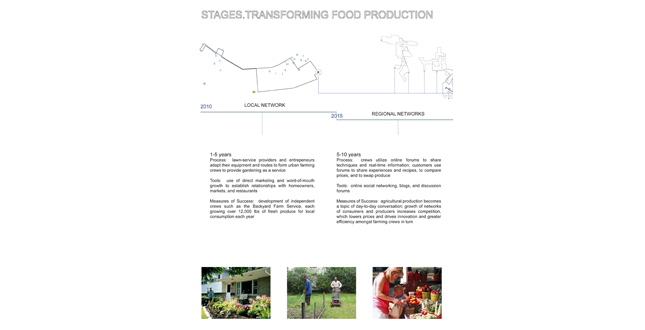
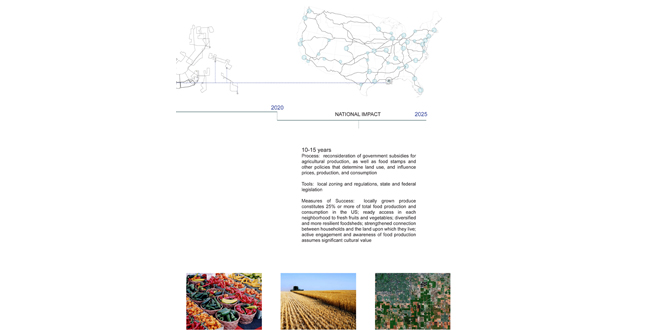
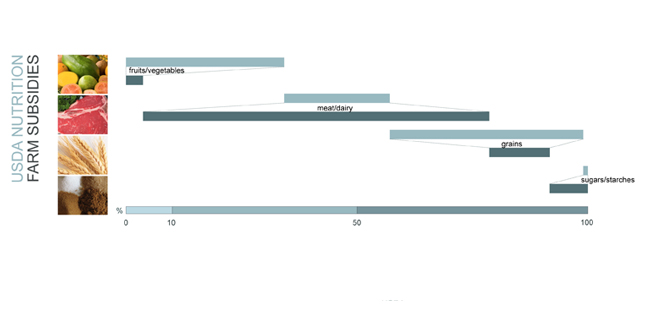 Close Me!
Close Me!Stages, Transforming Food Production The USDA recommends that 34.6% of an individual’s diet consist of fruits and vegetables, but that sector of agricultural production receives merely 0.37% of federal subsidies. In contrast, the USDA recommends that less than 1% of an individual's diet consist of sugars and oils, but that sector receives over 10% of those same subsidies. Can the redirection of just 4–5% of farm subsidies towards business models such as the Backyard Farm Service accelerate the diversification and localization of farming practices and food delivery?
Download Hi-Res ImageImage: Visual Logic
Image 13 of 13
Project Statement
The food delivery system in the United States has evolved around the points and lines of infrastructure rather than the specifics of climate, soils, and water. This research takes the form of a business plan that looks to the existing model of lawn-service providers in order to suggest methods for localizing food production, enhancing ecological diversity and food security, and physically reintegrating agricultural production into the fabric of our cities and suburbs.
Project Narrative
Food Delivery
—2011 Professional Awards Jury
In an era of cheap fuels and on-demand shipping, the food delivery system we have in the United States has evolved around the points and lines of infrastructure rather than the specifics of climate, soils, and aquatic resources. The processing, delivery, and consumption of food is driven more by the efficiencies of motorized transportation and the exigencies of the economy than by ecological considerations. In providing consumers with a wide variety of foods in- or out-of-season at the lowest prices possible, farmers and distributors utilize trucks, trains, ships, and airplanes to fill the shelves of supermarkets and pantries with agricultural products from around the country and from around the world. Even produce grown in the United States travels 1,500 miles, on average, before it is sold. Biological nutrients and organic matter are scattered across the globe according to the locations of ports and runways rather than the needs of ecosystems and watersheds. The terms "locally-grown" and "food miles" have become part of today's common parlance, as Americans have become increasingly aware of the ecological costs of contemporary patterns of industrial agriculture and food consumption.
Though the United States imported an estimated $77.5 billion in agricultural products in 2010, in addition to $15.1 billion in fertilizers and pesticides and $340 billion in crude oil to fuel the transportation systems that move these products, US food imports actually account for only 13% of the vegetables and 32% of the fruits and nuts consumed in the country. This statistic suggests that though the US may be incapable of supplying its fossil fuel needs, it would be feasible for the country to rely almost entirely upon American soils for the farming of fruits and vegetables consumed by its residents. To achieve this, the US would need to employ a number of strategies at different scales of production and consumption, one of which is outlined in this proposal.
Our proposal allows homeowners to play a part in the shift from a transport-based system to a more nimble and diversified ecosystems-based agriculture, by reinserting agricultural production into the popular notion of "home." In doing so, we can reduce the vehicle miles of the most important portion of each household's diet, and reestablish local nutrient cycles and ecological well-being household by household, within the unique geographic context and culture of each neighborhood. While hyper-local food production will never replace industrial agriculture and global food imports in full, the ubiquitous yard upon which each American home is set holds the potential for each household to reposition itself as producer and consumer.
The Model: Lawn-Service Provision
Crews of men clad in drab uniforms and wielding high-powered instruments, move rapidly through our suburbs and cities each day. They are tasked with maintaining the yards of over 34 million American households, and they do so with the utmost efficiency and at the lowest cost possible for each client homeowner. A visit to the average yard to "mow and blow" takes a crew of three no more than thirty minutes and costs homeowners but a small fraction of their disposable incomes. A single crew utilizing a mobile infrastructure of trucks and portable equipment can maintain yards for upwards of sixty homeowners—significant acreage when considered in aggregate.
Lawn-service providers and landscaping crews are ubiquitous in America's residential neighborhoods—the use of lawn-service providers has, over the last three decades, become less of a luxury and more an indispensable part of everyday life for even middle-class families. There are well over 5,000 professional lawn care companies in the United States alone, with 921,900 documented workers employed in the landscaping and groundskeeping industries—that far outnumbers the 438,490 workers in all of the farming, fishing and forestry occupations combined. The demand for lawn care continues to rise with the construction of single-family homes. With readily available cheap labor and a relatively modest investment in equipment as the only requirements for entry into the field, the lawn-service industry now comprises overlapping networks of providers spanning the country.
We study lawn-service provision as a form of farming in which the farmer goes directly to the customer, in which the act of farming is integrated into the rhythms of everyday life, in which the predilections and site conditions of each customer and their yard trump the dictates of industrial efficiency, and in which the convenience of the customer and the cultural value of a well-maintained landscape outweigh the productive value and ecological consequences of plant cultivation. The key to localizing food production lies, then, in tapping the remarkable potential of the existing lawn-service industry.
Our proposal begins with two assumptions, that there is a growing demand amongst consumers for fresh, locally-grown produce and for more sustainable lifestyles, and that people who want to garden, have the know-how, and have the time to garden already do garden. The lawn-service industry serves as a model for how the farming of produce can become integral to the lifestyle of American families, without necessitating an investment on the part of the homeowner in farming equipment, time, or agricultural education. Instead, networks of local urban farmers, acting much as lawn-service providers already do, will provide farming as a service to individual clients.
In this scheme, the vast acreage of American lawns becomes an expansive reservoir of arable land. Through negotiations with individual homeowners, the farmers adapt farming techniques and marketing strategies to the fragmented residential landscapes of our cities and suburbs. Utilizing their professional farming techniques and professional tools, these farmers provide agricultural services at low cost and with maximum convenience for homeowners, bringing the industrial efficiency and higher yields of farming to the realm of home gardening.
The Business Plan: "Backyard Farm Service"
A crew of three travels from yard to yard in trucks adapted from the ones used by lawn-service providers today, with routes planned to maximize the efficiency of their movements, and to harvest specific products that are delivered on short notice to local restaurants and markets. Each day begins and ends at a central location where equipment is stored, transplants seeded, and where processing and staging takes place. Each month, the crew visits each property a minimum of six times, providing basic lawn maintenance in addition to maintaining the gardens. Visits range from thirty minutes to three hours, depending on the needs of the agricultural beds.
The homeowners receive the bulk of the harvest delivered from their personal gardens onto their front doorsteps, with the farmers marketing a smaller portion of the produce to local restaurants and markets. A single garden of 800 sq. ft. can provide 400 pounds of fresh produce for each household, with an additional 240 pounds to be sold elsewhere by the farmers. Such an operation would, in farming numerous residential yards, rival the productivity and income generation of a typical CSA (community supported agriculture) farm out in the countryside.
The Backyard Farm Service strategy and business model adapts a number of techniques, processes, and technologies to achieve greater efficiency and lower costs. These include:
- transplanting rather than planting from seed to minimize time spent on-site during planting season and to maximize the growing season and success rate of each planting
- strategic use of mulch to minimize the amount of time spent weeding, while reducing soil compaction, moisture loss, and improving soil quality over time
- managing on-site composting of each household's organic waste as well as that of restaurants and markets, to provide a ready source of humus—in contrast to the current practice of bagging and dumping organic waste in landfills—in order to cycle nutrients and ecological resources locally
- utilizing low-tech drip irrigation (off-the-shelf valves with perforated flexible tubing) fed by each household's on-site taps and rainwater barrels to reduce water consumption
The proposal's urban farming crews tie into existing systems of local food production, distribution and consumption, with each crew establishing relationships with homeowners, restaurants, grocery stores, farmers markets, caterers, and schools in order to develop markets for locally-grown produce. Because the food is grown and consumed close to point of production, there are minimal processing and storage costs, orders can be filled on the same day, and customers have expanded access to the freshest seasonal produce possible. Taking place across multiple sites, the proposed farming practice is more diverse and adaptable in managing pests and diseases.
Individual crews may also offer more specialized services depending on their expertise—one may emphasize fruits and berries in their plantings, while another may introduce high-profit mushroom farming, edible flowers, or even chickens and beekeeping into the agricultural mix. Clients within these networks may use online forums to discuss their gardens' yields, to share recipes, and possibly to trade portions of their harvests amongst themselves, especially when certain vegetables are in particular abundance.
Conclusion: Localizing Food Production
The reframing of the lawn-service industry forms the basis of our proposal. We ask not that every American tear up their lawns—an untenable proposition in the present day and foreseeable future—but that every homeowner is offered the means to become local food producers without requiring them to abandon their jobs and take up farming on their own. Our strategies can be implemented anywhere homeowners and yards exist, while relying on local knowledge and farmer-to-household relationships. Though modest in terms of technical requirements or shifts in policy, "Backyard Farm Service" builds on existing business models, infrastructural capabilities, and current trends in cultural values and consumer desires to suggest how we can diversify and localize food production in order to enhance each neighborhood's ecological diversity and food security, to physically reintegrate agricultural production into the fabric of our cities and suburbs, and to bridge the psychic gap between farming and everyday consumption that has formed over the last century with the advent of modern agriculture.
Sources
1)US Bureau of Labor Statistics 2)How much do you spend on your lawn?: Statistics and Facts Concerning Lawn Care and Landscaping, www.backyardnature.com 3)How to Start a Lawn Care Business, www.mowingformoney.com 4)Economic Impacts of the Turfgrass and Lawncare Industry in the United States, University of Florida IFAS Extension 5)USDA Agricultural Projections: 2010 and US Agricultural Trade Outlook Forecast: 2009, United States Department of Agriculture Foreign Agricultural Service 6)Transportation Statistics Annual Report: 2008, Bureau of Transportation Statistics 7)US Agricultural Trade: Imports and Foreign Agricultural Trade of the United States, United States Department of Agriculture Economic Research Service 8)The Impact of Home and Community Gardening in America,National Gardening Association 9)Costs and Returns for CSA Operations in the Northeast, University of Massachusetts 10)Determining Prices for CSA Share Boxes, Iowa State University Extension
Project Resources
Visual Logic
Sam Fox School of Design and Visual Arts, Washington University in St. Louis, Natalie Yates, Assistant Professor, Associate ASLA
Robert Reich School of Landscape Architecture, Bradley Cantrell, Associate Professor
Waggonner & Ball Architects, Aron Chang
Manning Architects, Patrick Michaels, ASLA, Landscape Architect






